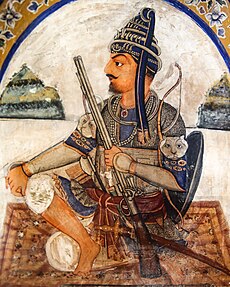Baba Hanuman Singh | |
|---|---|
 Mural of Hanuman Singh from Gurdwara Baba Atal in Amritsar, circa 19th century | |
| Jathedar of the Akal Takht | |
| In office 1823–1846 | |
| Preceded by | Phula Singh |
| Succeeded by | Prahlad Singh |
| 7th Jathedar of Buddha Dal | |
| In office 1823–1846 | |
| Preceded by | Phula Singh |
| Succeeded by | Prahlad Singh |
| Personal details | |
| Born | Hanuman Singh November 1755 Naurang Singh Wala, Firozpur, Punjab |
| Died | 1846 (age 90–91) Sohana, Mohali, Punjab |
| Parents |
|
| Part of a series on |
| Sikhism |
|---|
 |
Baba Hanuman Singh (1755 – 1846),[1] also known as Akali Hanuman Singh or Amar Shaheed Baba Hanuman Singh, was a Nihang Sikh and was the 7th Jathedar of Budha Dal and Jathedar of Akal Takhat.[2] He was the successor of Akali Phula Singh.[3][4] He was the first one who fought against the British. He attained martyrdom during a battle with the British and Patiala Stac in 1846.
- ^ Nihang, Nidar Singh (2008). In the master's presence : the Sikhs of Hazoor Sahib. Parmjit Singh. London: Kashi House. p. 161. ISBN 978-0-9560168-2-9. OCLC 260209971.
In the aftermath of Sobraon, the Buddha Dal survivors sought respite among the independent Sikh principalities south of the Satluj. Their elderly jathedar, Akali Hanuman Singh Nihang (d. 1846), received an invitation from the young king of Patiala, Narinder Singh (1814-1862).
- ^ The Sikh Courier, Volumes 9-12. Sikh Cultural Society of Great Britain. 1977. p. 24.
- ^ Bansal, Bobby Singh (2015). "Notes and References". Remnants of the Sikh empire : historical Sikh monuments in India and Pakistan. New Delhi, India. ISBN 978-93-84544-89-8. OCLC 934672669.
53. Akali Phula Singh was born in the village of Shinh near the town of Banga in Jalandhar district in 1761. He was the head of the fanatical sect the Akalis until his death in 1823. He was succeeded by Akali Hanuman Singh as the seventh leader of the Nihangs...
{{cite book}}: CS1 maint: location missing publisher (link) - ^ Singh, Kamalroop. "A wedding party, something old, something new: The history of the formation of the British-Sikh regiments." p. 63. HumaNetten 36 (2016): 57-80.